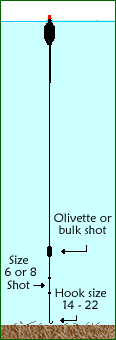Members Article
Secretary Steve Simmonds shares some of his secrets that may help you catch more fish on our stretches of the River Arun.
Many of our Members who have not fished a tidal river before find it rather daunting, and maybe after a couple of sessions give up, thinking it is too hard. Those that persevere and get to understand how the different stages of the tide affect the fish will tell you that it is a very underrated river, with lots of potential for not only producing large bags of fish, but also some very large individual specimens of most species. One of the most pleasurable ways of fishing the Arun is with a running line, here are a few pointers that you may find helpful if you are new to tidal river angling.
Rods
Float fishing with a conventional rod and line on the Arun was transformed about 10 years ago when a number of rod manufacturers brought in ‘long’ rods. These rods, normally between 17 and 20 feet long made it possible to fish many swims on the Arun whatever the state of the tide without having to revert to slider rigs. There have always been a few shallower pegs notably the gravel at the top end of Hardham, the ‘Point’ at Watersfield and the gravel bar at the bottom end of Watersfield. It is possible to fish all these areas with a thirteen foot rod.
Techniques
When fishing within a foot or so of the bottom, as a general rule, to fish a line between the centre of the river and the near bank, trotting with a float fixed top and bottom is the technique to use.
If fishing a line further across the river a large straight waggler with about half the loading down the line is probably the best method.
There are some occasions when the fish come up in the water, although these are normally bleak and can prove a nuisance, however if this is your quarry than a light waggler rig fished at 3 – 4 foot depth with the bulk shot around the float and a couple of no. 8’s down the line is effective.
Line
When trotting it is best to use a floating line, you are able to keep better contact with the float. Floating lines such as Drennan ‘Float’ are available, alternatively spray your spool with a proprietary floating line spray. When fishing a waggler rig you want a sinking line such as Maxima, again there are sprays available to help sink your line. In both cases I would use a 3lb main line and a high tech hooklength between 0.08 and 0.11 mm. On the occasions when you do find bream then you will need to step up to 4 or 5lb main line with hooklengths of 0.13 to 0.15 mm.
Hooks
For general purpose river fishing you can’t go wrong with Kamasan B520’s or similar and sized to suit your bait. For a single maggot or caster I would use either 22 or 20 stepping up to 18 or 16 for bigger baits.
 Floats for trotting There are two major requirements:
Floats for trotting There are two major requirements:
- Sufficient weight to get the bait down.
- A shoulder on the float to enable you to ‘hold back’ whilst trotting.
Two float shapes that can be used are:
- Bodied Avons
- Bolognaise
The Avon pattern is well known and can be found in most anglers float boxes.
The Bolognaise is a newer pattern and was developed on the continent specifically for use with long rods.
With either float the technique is essentially the same. Cast directly in front of you to the desired distance and hold back until the weight has gone down and settled.
Then slowly inch the float through the swim occasionally ‘holding back’ ie stopping any further line from running out. This causes the bait to rise and when you let the line go again it will flutter back down through the water. This is normally very tempting to the fish and will induce bites.
As you trot through the swim carefully note any snags, you can then hold back to allow the terminal tackle to clear these. Also note the point where you get bites and try and hold back here as this is hopefully where the fish are queued up.
Bait and Groundbait
Maggots and caster are normally sufficient as bait although it might be worth trying a small piece of worm or a grain of sweet corn and it is always worth trying a bit of breadflake. Groundbait needs to be quite heavy and commercial mixes such as River Ace or River 3000 are satisfactory. Alternatively you can use a binder such as PV1 with lighter mixes. Its always worth adding some hemp and casters. I tend to steer clear of adding maggot or pinkie as these can quite easily be washed out of your swim and also act as a great attractant for eels, which I would prefer to avoid.
Tip – Don’t forget that the Arun is tidal, you therefore need to adjust your depth at intervals during a session. Even minor adjustments can make a big difference and keep you in contact with the fish.




